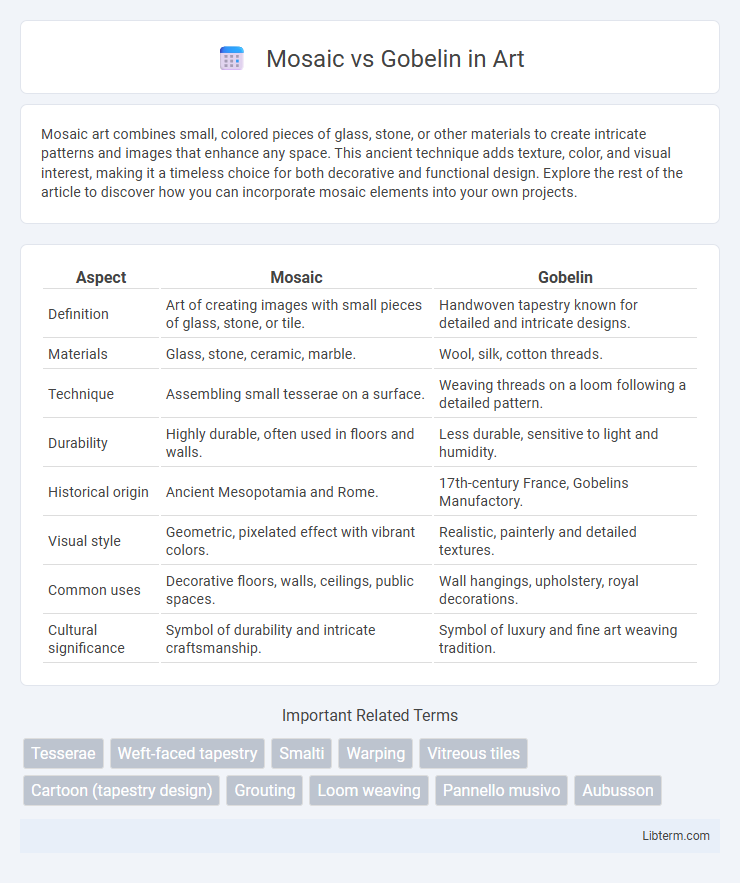Mosaic art combines small, colored pieces of glass, stone, or other materials to create intricate patterns and images that enhance any space. This ancient technique adds texture, color, and visual interest, making it a timeless choice for both decorative and functional design. Explore the rest of the article to discover how you can incorporate mosaic elements into your own projects.
Table of Comparison
| Aspect | Mosaic | Gobelin |
|---|---|---|
| Definition | Art of creating images with small pieces of glass, stone, or tile. | Handwoven tapestry known for detailed and intricate designs. |
| Materials | Glass, stone, ceramic, marble. | Wool, silk, cotton threads. |
| Technique | Assembling small tesserae on a surface. | Weaving threads on a loom following a detailed pattern. |
| Durability | Highly durable, often used in floors and walls. | Less durable, sensitive to light and humidity. |
| Historical origin | Ancient Mesopotamia and Rome. | 17th-century France, Gobelins Manufactory. |
| Visual style | Geometric, pixelated effect with vibrant colors. | Realistic, painterly and detailed textures. |
| Common uses | Decorative floors, walls, ceilings, public spaces. | Wall hangings, upholstery, royal decorations. |
| Cultural significance | Symbol of durability and intricate craftsmanship. | Symbol of luxury and fine art weaving tradition. |
Introduction to Mosaic and Gobelin
Mosaic art involves creating images by assembling small pieces of colored glass, stone, or other materials, often used in ancient and modern decorative art. Gobelin refers to a type of luxurious tapestry originating from the Gobelins Manufactory in France, renowned for its intricate weaving techniques and rich historical significance. Both art forms showcase detailed craftsmanship but differ fundamentally in medium and method, with mosaic focusing on assemblage and Gobelin on textile weaving.
Historical Origins: Mosaic vs Gobelin
Mosaic art dates back to ancient Mesopotamia and Classical Antiquity, characterized by assembling small pieces of colored glass, stone, or other materials to create intricate patterns and images. The Gobelin tapestry tradition originates from 17th-century France, specifically the Royal Gobelins Manufactory established under Louis XIV, renowned for producing luxurious woven tapestries with detailed, pictorial designs. While mosaics emphasize durable, architectural decoration, Gobelin tapestries highlight fine textile craftsmanship and royal patronage in European art history.
Artistic Techniques: Comparing Methods
Mosaic art involves assembling small pieces of colored glass, stone, or ceramic called tesserae to create intricate images with a textured surface, emphasizing light reflection and durability. Gobelin tapestries, woven on a loom using dyed wool and silk threads, showcase detailed pictorial scenes with rich color gradations and soft, fabric-like textures. While mosaics highlight geometric precision and permanence, Gobelins emphasize painterly shading and textile craftsmanship.
Materials Used in Mosaic and Gobelin
Mosaic art typically uses small pieces of glass, stone, ceramic, or other durable materials called tesserae, which are assembled to form intricate patterns and images. Gobelin tapestries are crafted from dyed wool, silk, and sometimes gold or silver threads, woven together on a loom to create detailed fabric artwork. While mosaics rely on hard, rigid materials for durability and texture, Gobelins emphasize rich textiles and vibrant colors achieved through skilled weaving techniques.
Visual Style and Aesthetic Differences
Mosaic art features small, colored pieces of glass, stone, or ceramic arranged to create intricate, geometric patterns and often exhibits a textured, fragmented visual style with vibrant color contrasts. Gobelin tapestries demonstrate a softer, woven aesthetic with detailed pictorial scenes and nuanced shading, emphasizing smooth gradations and rich, intricate imagery derived from traditional French weaving techniques. While mosaics rely on the reflective qualities of individual tesserae for visual impact, Gobelin tapestries evoke depth and realism through fine threadwork and elaborate narrative compositions.
Popular Themes and Motifs
Mosaic art often features geometric patterns, religious iconography, and natural elements such as flowers and animals, reflecting its historical use in ancient Roman and Byzantine architecture. Gobelin tapestries are renowned for intricate scenes depicting mythology, royal court life, and pastoral landscapes, showcasing elaborate storytelling through textile art. Both mediums emphasize detailed craftsmanship, but mosaics prioritize durability and vibrant color contrasts, while Gobelin tapestries highlight narrative depth and texture.
Durability and Longevity
Mosaic art, composed of small, durable pieces of glass, stone, or ceramic, offers exceptional longevity due to its resistance to weathering and fading. Gobelins, crafted from intricate tapestry weaving with wool or silk, tend to be more susceptible to wear, light damage, and environmental factors over time. While mosaics often remain vibrant and intact for centuries, Gobelin tapestries typically require careful preservation to maintain their durability and aesthetic value.
Applications in Architecture and Interior Design
Mosaic art, characterized by small, colored pieces of glass or stone, enhances architectural spaces by creating intricate patterns on floors, walls, and ceilings, offering durability and vibrant visual appeal in both indoor and outdoor settings. Gobelin tapestries, renowned for their detailed woven scenes and rich textures, are predominantly used in interior design to add warmth, historical context, and luxury to walls, upholstery, and furniture accents. Both applications serve distinct aesthetic and functional roles, with mosaics often favored for surfaces exposed to moisture or heavy use, while Gobelin tapestries contribute to acoustic insulation and decorative richness in living spaces.
Contemporary Trends in Mosaic and Gobelin Art
Contemporary trends in mosaic art emphasize the use of mixed media, integrating traditional tesserae with glass, metal, and recycled materials to create vibrant, textured installations. Gobelin art has evolved through the fusion of classic tapestry techniques with modern digital printing, enabling intricate designs and rapid production while preserving artisanal craftsmanship. Both art forms increasingly explore abstract and environmental themes, reflecting global cultural narratives and sustainability concerns.
Choosing Between Mosaic and Gobelin for Your Project
Choosing between Mosaic and Gobelin depends on your project's aesthetic and functional needs. Mosaic art, composed of small, colored pieces of glass, stone, or tile, offers vibrant textures and durability ideal for outdoor or high-traffic spaces. Gobelin tapestries, woven with intricate patterns and rich fabrics, provide luxurious detail and warmth, best suited for interior decoration and historical or traditional designs.
Mosaic Infographic

 libterm.com
libterm.com